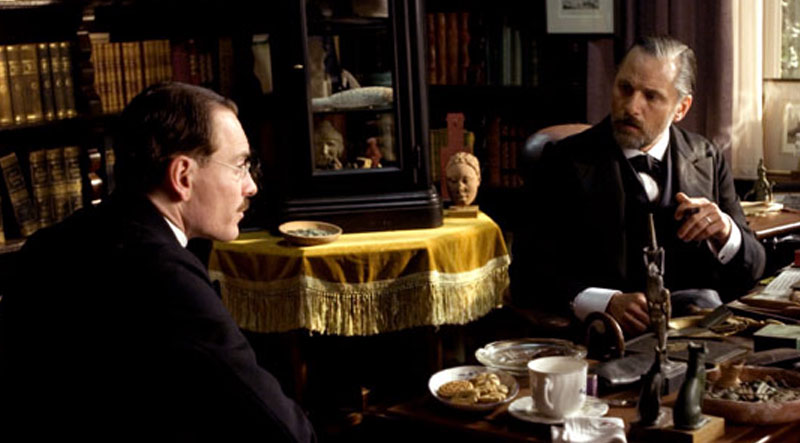
|

|

|

|

|

|

|

|

|

|

|

|


"Michael Fassbender and Viggo Mortensen are sensational as Carl Jung and Sigmund Freud in 'A Dangerous Method.'"
I’m not exactly a cultist for David Cronenberg — I didn’t think A History of Violence was very convincing, or even that The Fly was a great horror film — but I was primed, in Toronto, to see A Dangerous Method, in which Viggo Mortensen plays Sigmund Freud and Michael Fassbender plays Carl Jung. Keira Knightley — yes, Keira Knightley — plays the sexed-up, tormented patient-turned-psychoanalyst prodigy who comes between the two of them.
When you consider that Freud and Jung, along with Einstein, were arguably the most influential thinkers of the last hundred years, there have been precious few dramatic features that have attempted to deal with who they really were. (Montgomery Clift played Freud in a 1962 John Huston biopic, and that movie was every bit as repressed as it sounds.) I went into A Dangerous Method eager to see Freud and Jung come to life on screen as they might, perhaps, have really been. And Cronenberg, at his most restrained, delivers — the movie, though less overtly exciting than some of his others, gave me just what I wanted. It’s a play of sensuality and ideas rooted in the opposing spirits (rational vs. mystical, Jewish Austrian vs. Protestant Swiss) of these two infamous allies-turned-adversaries.
The movie is framed as Jung’s story, and Michael, courtly and polite, hidden behind a clockmaker’s mustache, makes the bourgeois but searching Jung a paradoxical explorer: He’s devoted to his wealthy wife (Sarah Gadon), and to the children she keeps bringing forth, yet Knightley’s Sabina, who becomes his patient and lover, represents more than temptation. She’s his chance to break on through to the other side — to the secret dark truth of pain, masochism, and sex as creative destruction. Knightley’s performance, with its gargantuan mood swings from jaw-gnashing psychosis to femme-fatale hunger, has already divided a lot of people at the festival, but I think she works just fine. The movie’s real, tragic love story is the increasingly frayed bond between Freud and Jung.

Freud, who Jung reveres as a mentor and father figure, accepts the erotic intensity of everyday life but has no real use for it. He’s the man who defined the pleasure principle, yet his holy mission is to figure out how to live within its boundaries. It was a stroke of inspiration to cast the virile, rock-solid confident Mortensen as the godfather of neurosis. Puffing on a cigar, he makes Freud a charismatic control freak, a man all too eager to engage in dream analysis yet too much of a self-designated authority figure to put his own dreams up for dissection. Jung, working in his own clinic in Switzerland, starts out as Freud’s disciple, but when Jung begins to advocate for the irrational, for the power of coincidence, for sex as magic, he’s really arguing for a different kind of psychoanalysis — for hope in place of determinism. Fassbender brings Jung the tormented angelic mind-bender to life. He and Mortensen turn Jung and Freud into X-men of the unconscious. They know they’re freaks, and that’s their liberation.
The original source is here
